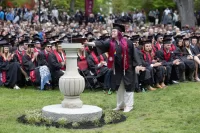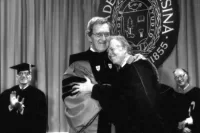
Bates student writing first-ever text-to-speech synthesis program for Nepali language
Many of us talk to our computers, but Sameer Raj Maskey, a junior physics and math double major at Bates College, is working to make his talk back in various languages. Maskey, a native of Nepal, is finishing work on the first ever text-to-speech software for the Nepali language, which will allow a computer to “speak” typed Nepali text.
“I had to speak a lot of sentences into the computer,” Maskey said. His work included reading through a 6,000-word Oxford dictionary in order to create a set of phonetic rules for the computer to follow. “A computer needs to know what the real sounds of the words are,” he explained, using the word “read” as an example by varying the pronunciation between past and present tense.
Professor of Math John Rhodes, Maskey’s project advisor at Bates College, called Maskey’s motivation extraordinary. Maskey, whose project crosses interdisciplinary boundaries between physics, math and computer science, came to Bates with his project in mind. When he needed help from specialists in language synthesis, he setup work at Carnegie Mellon University and three other schools and secured funding to do so from Bates College. When finished, the program will be made available free to the public through Carnegie Mellon University.
Maskey dreams of creating a program that allows voice-to-voice language translations where the user speaks and the computer speaks back. While this is still a quite few years away, Maskey’s project isn’t just a dream, Rhodes said. He believes that Maskey’s work will become even more important as computers get smaller. “As long as we’re confined to keyboards and monitors there’s a limit to how small things can be,” Rhodes said. Because of their high price, computers are scarce enough in Nepal that Maskey didn’t use one until he was in high school. Now he studies computer science along with his chosen majors. At home, Maskey visited a local cybercafe to get online and eventually search for colleges. It was in a cybercafe where several Bates students studying abroad in Nepal noticed him emailing a friend about his acceptance to Bates and helped convince him to attend.




